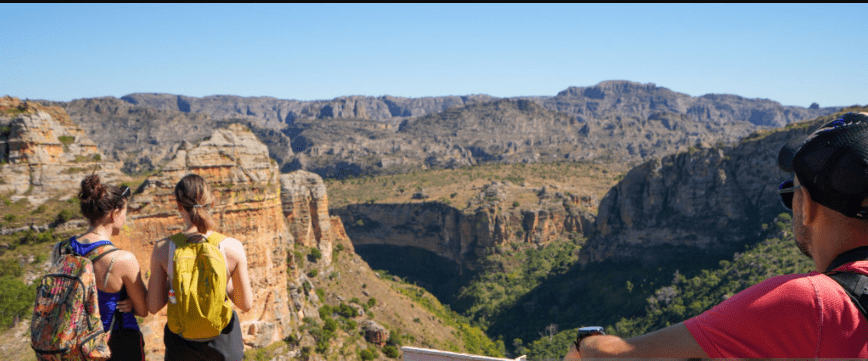Essential Gear for Hiking in East Africa: Your Ultimate Guide to Adventure and Preparedness
East Africa is a hiker’s paradise, offering breathtaking landscapes, from the snow-capped peaks of Mount Kilimanjaro to the lush trails of the Rwenzori Mountains and the vast savannahs of Kenya’s Aberdare Range. Whether you’re a seasoned trekker or a first-time adventurer, having the right essential gear for hiking can make the difference between an unforgettable journey and a challenging ordeal.
This guide will walk you through the must-have equipment, clothing, and accessories to ensure you stay safe, comfortable, and inspired as you conquer East Africa’s majestic trails.
Why the Right Gear Matters
Hiking in East Africa presents unique challenges—unpredictable weather, high altitudes, rugged terrain, and remote locations. The right essential gear for hiking ensures:
Safety – Protection from wildlife, extreme weather, and injuries.
Comfort – Reduced fatigue, blisters, and exposure-related illnesses.
Efficiency – Lightweight, durable equipment that enhances mobility.
Confidence – Knowing you’re prepared boosts morale and enjoyment.
Without proper gear, even the most scenic trails can become daunting. Let’s dive into the essentials.
1. Footwear: The Foundation of Every Hike
Your feet carry you through every step of the journey, so investing in the right footwear is non-negotiable.
Sturdy Hiking Boots
Waterproof & Breathable – East Africa’s trails range from muddy rainforests to arid plains. Boots with Gore-Tex or similar technology keep feet dry.
Ankle Support – Rocky and uneven terrain demands high-ankle boots to prevent sprains.
Durable Soles – Vibram soles offer excellent grip on slippery and loose surfaces.
Quality Hiking Socks
Moisture-Wicking Material – Merino wool or synthetic blends prevent blisters.
Cushioned Design – Extra padding reduces impact on long hikes.
Pro Tip: Break in your boots before the hike to avoid painful blisters.
2. Clothing: Layering for Versatility
East Africa’s weather can shift from scorching heat to freezing temperatures in hours, especially at higher altitudes. The key is layering.
Base Layer (Moisture Management)
Material: Merino wool or synthetic fabrics (avoid cotton—it retains moisture).
Function: Wicks sweat away, keeping you dry and warm.
Mid Layer (Insulation)
Fleece Jacket or Light Down Puffer – Retains body heat in cold conditions.
Outer Layer (Weather Protection)
Waterproof & Windproof Jacket – A must for sudden rain or mist.
Convertible Pants – Zip-off legs adapt to changing temperatures.
Pro Tip: Pack lightweight, quick-dry clothing to minimize bulk.
3. Backpack: Your Mobile Command Center
A well-fitted backpack ensures comfort and accessibility.
Features to Look For:
30-50L Capacity – Enough for day hikes; 60-80L for multi-day treks.
Padded Shoulder Straps & Hip Belt – Distributes weight evenly.
Rain Cover – Protects gear from downpours.
Multiple Compartments – Easy organization of essentials.
Pro Tip: Test your loaded backpack before the hike to adjust straps for optimal fit.
4. Navigation Tools: Don’t Get Lost
While guides are common in East Africa, having your own navigation tools is crucial for solo hikers.
Essential Tools:
GPS Device or Smartphone with Offline Maps (Apps like Maps.me or Gaia GPS).
Compass & Physical Map – Electronics can fail.
Altimeter Watch – Tracks elevation gain, helpful for high-altitude hikes.
Pro Tip: Learn basic map-reading skills before your trip.5. Hydration: Water Is Life
Dehydration is a real risk, especially in hot climates.
Must-Have Hydration Gear:
3-Liter Hydration Bladder – Easy sipping without stopping.
Water Purification Tablets or Filter – Safeguard against waterborne diseases.
Collapsible Water Bottle – Lightweight backup.
Pro Tip: Drink small amounts frequently rather than large gulps occasionally.
6. Nutrition: Fuel for the Trail
Hiking burns thousands of calories—pack energy-rich, lightweight food.
Best Hiking Foods:
Energy Bars & Nuts – Quick, calorie-dense snacks.
Dehydrated Meals – Just add hot water for a warm meal.
Electrolyte Tablets – Replenish lost minerals from sweating.
Pro Tip: Pack extra food in case of delays.
7. Shelter & Sleep System (For Multi-Day Hikes)
If camping overnight, these are non-negotiable:
Tent
Lightweight, Weather-Resistant – 3-season tents work for most conditions.
Sleeping Bag
Temperature-Appropriate – Check the rating (0°C to -10°C for high altitudes).
Sleeping Pad
Insulated & Compact – Provides cushioning and warmth.
Pro Tip: Practice setting up your tent before the trip.
8. First Aid & Safety Gear
Accidents happen—be prepared.
First Aid Kit Essentials:
Bandages, antiseptic wipes, blister treatment.
Pain relievers, antihistamines, rehydration salts.
Tweezers (for thorns or splinters).
Additional Safety Gear:
Whistle & Signal Mirror – For emergencies.
Multi-Tool or Knife – Versatile for repairs and food prep.
Pro Tip: Know basic first aid before heading out.
9. Sun & Insect Protection
East Africa’s sun is intense, and insects can carry diseases.
Sun Protection:
SPF 50+ Sunscreen – Reapply every 2 hours.
UV-Blocking Sunglasses – Protects eyes from glare.
Wide-Brim Hat – Shields face and neck.
Insect Protection:
DEET-Based Repellent – Keeps mosquitoes and ticks away.
Permethrin-Treated Clothing – Extra defense against bugs.
Pro Tip: Check malaria risks in your hiking area.
10. Miscellaneous Must-Haves
Trekking Poles
Reduce knee strain on steep descents.
Headlamp (+ Extra Batteries)
Essential for early starts or unexpected night hikes.
Dry Bags
Keep clothes and electronics dry.
Camera or Smartphone
Capture the stunning landscapes!
Adventure Awaits with the Right Gear
Hiking in East Africa is a transformative experience—one that challenges your limits and rewards you with unparalleled beauty. By packing the essential gear for hiking, you equip yourself not just for survival, but for triumph.
Every step taken with preparation is a step toward confidence, joy, and unforgettable memories. So lace up those boots, pack smart, and embrace the adventure that awaits in the wild, wondrous trails of East Africa.
The mountains are calling—will you answer?





